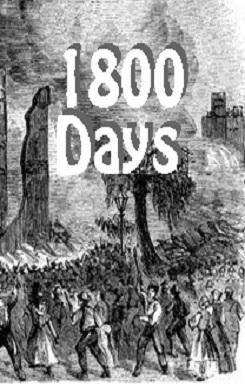Big Mound, Dakota TerritoryJuly 23, 1863 |
 |
Federal Troops Engaged: 1st Minnesota Cavalry, 3d Minnesota Battery, and 6th, 7th, and l0th Minnesota Infantry.
Indian Troops Engaged:Santee and Teton Sioux
Brig. General Henry Hastings Sibley led his troops from Fort Ridgely, Minnesota, into the Dakotas, pursuing the Santee Sioux, who had initiated an uprising in the Minnesota River Valley in August 1862. The Santee had joined forces with the Teton Sioux.
Having marched all day on July 24, 1863, Sibley's scouts, around 1:00 pm, reported that they had spotted a large Native American camp a few miles away. Sibley established a camp on a nearby salt lake and set his men to entrenching it for protection. While in the process of making camp, numerous Indians appeared expressing friendship. A number of them approached the scouts gathered about 300-400 yards from the camp and began talking with them. Surgeon Josiah S. Weiser, 1st Regiment Minnesota Mounted Rangers, joined the assembly, but soon afterwards a Sioux shot and killed him. The scouts attempted to kill the attacker but he escaped.
By order of Sibley, Lieut.J. C. Whipple planted his artillery on a hill opposite Big Mound and in a short time drove them from their position to the open prairie where the cavalry could get at them. Indians who had hidden behind the surrounding ridges now emerged and attacked. In detachments, the soldiers went out to meet the Indians. Sibley, with some men, approached the "Big Mound" on the opposite side of the ravine. He attempted to dislodge those Sioux who were on the upper part of the large ravine firing at the infantry and cavalry with impunity.
The Union forces displaced these and other well-placed Sioux in the surrounding ridges by accurate artillery fire and forced them into the broken prairie where they fled in confusion. The mounted troops, with some of the infantry and artillery following, set out in pursuit. A running battle ensued for the rest of the day. After two or three futile attempts to make a stand the Indians fled in the direction of Dead Buffalo lake.
Before dark, the soldiers broke off the pursuit and returned to camp as previously ordered, some not arriving until the next morning. The Sioux forces were broken and dispirited.
Location: Kidder County
Campaign: Operations against the Sioux in North Dakota (1863)
Date(s): July 24-25, 1863
Principal Commanders: Brig. General Henry Hastings Sibley [US]; Chief Inkpaduta
Estimated Casualties: Total unknown (US unknown; [I] 13)
Don't Miss a Single Issue! Subscribe for weekly updates and access to the back issues 
| ||||
John C. Rigdon, editor | ||||
| ||||
| Each volume contains 200 - 300 pages detailing the events which occurred during the month. | ||||
|

|
|||
| Eighteen Hundred Days This CD is the index to "All the Battles." It actually contains 4 indexes, sorted by year, by state, by name of battle in PDF format, and an Excel spreadsheet which you can use to manipulate the data on your own. | ||||

| ||||



